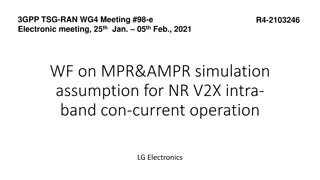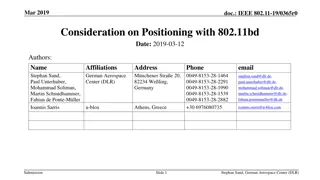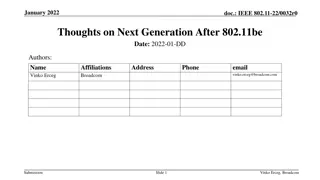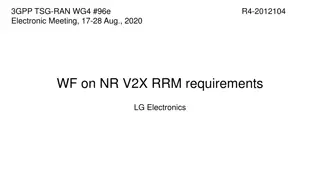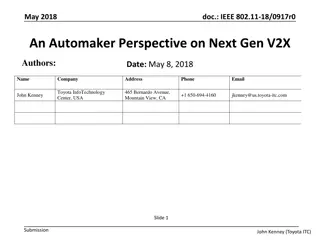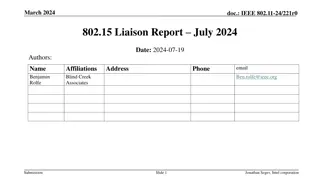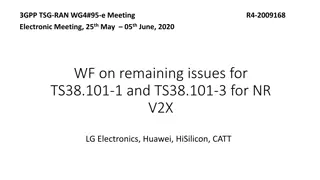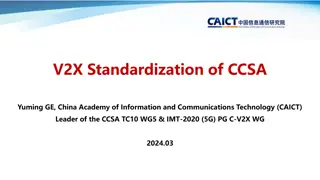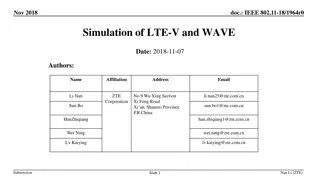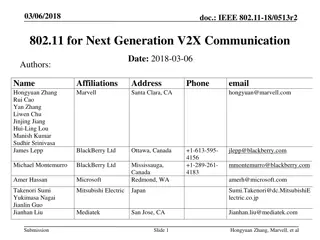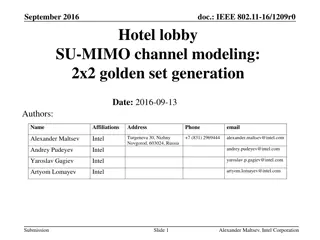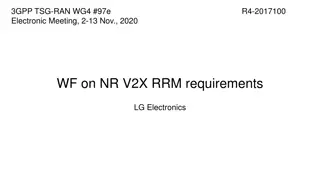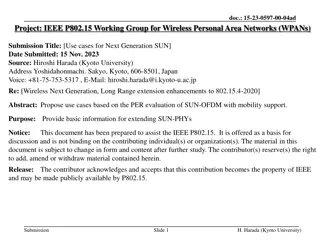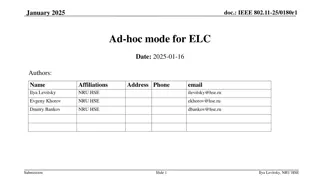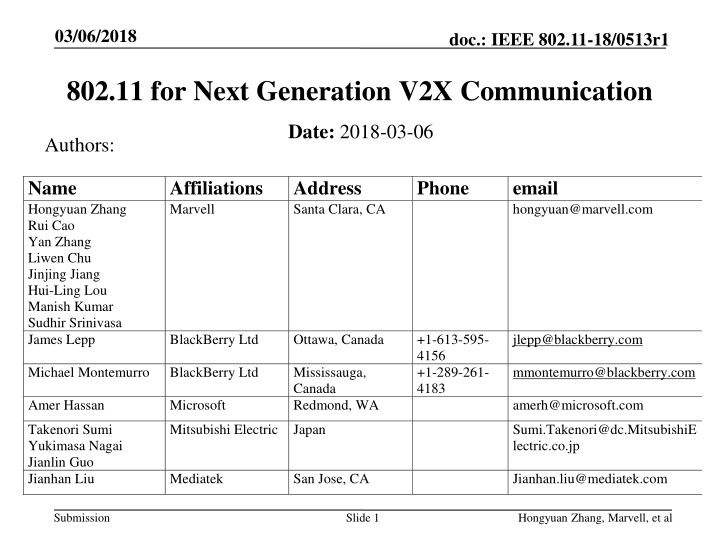
802.11p Evolution for V2X Communication: A Roadmap Proposal
Explore the evolution of 802.11 technologies for future-proofing V2X communication applications, including V2V and V2I, at high speeds and varying communication ranges. This proposal suggests initiating a study group to develop a long-term roadmap for V2X advancements.
Download Presentation

Please find below an Image/Link to download the presentation.
The content on the website is provided AS IS for your information and personal use only. It may not be sold, licensed, or shared on other websites without obtaining consent from the author. If you encounter any issues during the download, it is possible that the publisher has removed the file from their server.
You are allowed to download the files provided on this website for personal or commercial use, subject to the condition that they are used lawfully. All files are the property of their respective owners.
The content on the website is provided AS IS for your information and personal use only. It may not be sold, licensed, or shared on other websites without obtaining consent from the author.
E N D
Presentation Transcript
03/06/2018 doc.: IEEE 802.11-18/0513r1 802.11 for Next Generation V2X Communication Date: 2018-03-06 Authors: Name Hongyuan Zhang Rui Cao Yan Zhang Liwen Chu Jinjing Jiang Hui-Ling Lou Manish Kumar Sudhir Srinivasa James Lepp Michael Montemurro Affiliations Marvell Address Santa Clara, CA Phone email hongyuan@marvell.com BlackBerry Ltd Ottawa, Canada +1-613-595- 4156 +1-289-261- 4183 jlepp@blackberry.com BlackBerry Ltd Mississauga, Canada Redmond, WA mmontemurro@blackberry.com Amer Hassan Microsoft amerh@microsoft.com Takenori Sumi Yukimasa Nagai Jianlin Guo Jianhan Liu Mitsubishi Electric Japan Sumi.Takenori@dc.MitsubishiE lectric.co.jp San Jose, CA Jianhan.liu@mediatek.com Mediatek Submission Slide 1 Hongyuan Zhang, Marvell, et al
03/06/2018 doc.: IEEE 802.11-18/0513r1 Name Bo Sun Affiliations ZTE Address Xi an, China Phone email sun.bo1@zte.com.cn Saishankar Nandagopalan Hari Karunai Rick Zerod Satish Putta Jing Ma Kentaro Ishizu Fumihide Kojima Cypress NJ Saishankar.Nandagopalan@cyp ress.com hari.karunai@visteon.com Visteon Corp NICT 3-4, Hikarino-oka, Yokosuka, 239- 0847, Japan +81-46-847- 5444 majing@nict.go.jp Submission Slide 2 Hongyuan Zhang, Marvell, et al
03/06/2018 doc.: IEEE 802.11-18/0513r1 Abstract 802.11p is matured and robust for Dedicated Short Range Communications (DSRC). WLAN standard has evolved after 11p, with many matured technologies (e.g. LDPC, STBC etc). Leverage the evolution of the 802.11 technologies to future proof 11p/DSRC for new applications for vehicle-to-everything (V2X). Propose: start a study group to explore a long term roadmap for V2X. Submission Slide 3 Hongyuan Zhang, Marvell, et al
03/06/2018 doc.: IEEE 802.11-18/0513r1 Outline Review existing technologies Potential roadmap for new vehicle-to-everything (V2X) applications Possible next steps Submission Slide 4 Hongyuan Zhang, Marvell, et al
03/06/2018 doc.: IEEE 802.11-18/0513r1 I. Review: 802.11p (WAVE) 802.11p Overview: Used in rapidly varying communication environments, where the interval of the communication exchanges may be in very short, e.g., on the order of 10s or 100s of milli-seconds. V2X applications: communication between vehicles (V2V), between vehicle and the roadside infrastructure (V2I), or between vehicle to anything on or on the side of the road, while operating at speeds up to a minimum of 200 km/h for communication ranges up to 1 km. Submission Slide 5 Hongyuan Zhang, Marvell, et al
03/06/2018 doc.: IEEE 802.11-18/0513r1 802.11p Channelization 5.9 GHz band in USA (5.850 5.925 GHz), i.e., U- U-NII-4; and in Europe (5.855 5.925 GHz) FCC: Ch. 184: Public Safety Ch. 172: Collision Avoidance Safety Submission Slide 6 Hongyuan Zhang, Marvell, et al
03/06/2018 doc.: IEEE 802.11-18/0513r1 802.11p PHY/MAC PHY (BW=10MHz): 2x down clock of 11a BCC, 1SS GI=1.6us 3/4.5/6/9/12/18/24/27 Mbps More stringent ACI/AACI requirements 8us 8us 16us 8us 16us ... L-STF L-LTF L-SIG Data-1 Data-2 MAC: Outside the Context of a BSS (OCB) Transmissions Timing Advertisement Limited Frame sizes Submission Slide 7 Hongyuan Zhang, Marvell, et al
03/06/2018 doc.: IEEE 802.11-18/0513r1 Simulation for C2C Safety Applications Simulation settings: DSRC 10MHz, 1Tx-1Rx-1SS V2V radio channel models [1] (and Appendix) LENGTH: 300B for DSRC safety applications Rate: QPSK-1/2 for DSRC safety applications Comparison: 11p with BCC 11ac down-clocked by 2x (DC2x), with LDPC Submission Slide 8 Hongyuan Zhang, Marvell, et al
03/06/2018 doc.: IEEE 802.11-18/0513r1 802.11p robust for DSRC applications https://www.amazon.com/Kangaro os-Cootie-Catcher-Valentines-28- Count/dp/B078J4HKSY/ref=pd_si m_201_1?_encoding=UTF8&pd_r d_i=B078J4HKSY&pd_rd_r=265N WKPXDMSHPE04A739&pd_rd_ w=5pOjD&pd_rd_wg=zk1EZ&psc =1&refRID=265NWKPXDMSHP E Rural LOS, 10MHz, 1Rx, 1SS, QPSK-1/2, 300B Highway LOS, 10MHz, 1Rx, 1SS, QPSK-1/2, 300B 0 0 10 10 -1 10 PER -1 PER 10 -2 10 11p 11ac DC2: LDPC 11p 11ac DC2: LDPC 1dB -3 10 -2 10 SNR(dB) SNR(dB) Hongyuan Zhang, Marvell, et al Submission Slide 9
03/06/2018 doc.: IEEE 802.11-18/0513r1 802.11p robust for DSRC applications https://www.amazon.com/Kangaro os-Cootie-Catcher-Valentines-28- Count/dp/B078J4HKSY/ref=pd_si m_201_1?_encoding=UTF8&pd_r d_i=B078J4HKSY&pd_rd_r=265N WKPXDMSHPE04A739&pd_rd_ w=5pOjD&pd_rd_wg=zk1EZ&psc =1&refRID=265NWKPXDMSHP E Urban Approaching NLOS, 10MHz, 1Rx, 1SS, QPSK-1/2, 300B Urban Approaching LOS, 10MHz, 1Rx, 1SS, QPSK-1/2, 300B 0 0 10 10 -1 PER -1 PER 10 10 11p 11ac DC2: LDPC 11p 11ac DC2: LDPC 1dB -2 -2 10 10 SNR(dB) SNR(dB) Hongyuan Zhang, Marvell, et al Submission Slide 10
03/06/2018 doc.: IEEE 802.11-18/0513r1 Comparing other Technologies 802.11p: Based on 802.11a: robust performance for short packets. Products ready with actual deployments, extensive interop tests and field trials. Adopted or being considered by some regions. Cellular-V2X (C-V2X): Reusing LTE UL frame structure (Rel 14): require tight frequency and timing synchronizations Longer symbol and GI durations Leveraging more recent PHY technologies: e.g. more advanced coding. Less mature than 802.11p: no extensive field trials/testing so far. 802.11n/ac/ah/ax standardshave proven and matured technologies for V2X applications requiring longer packet sizes, higher throughput, larger Doppler and longer range, etc. A new 802.11 amendment to leverage evolution of 802.11 to future proof 11p/DSRC for V2X applications? Submission Slide 11 Hongyuan Zhang, Marvell, et al
03/06/2018 doc.: IEEE 802.11-18/0513r1 802.11p/V2X Use Cases V2X: Collision avoidance: V2V communication can reduce, mitigate, or prevent 81% of light-vehicle crashes by unimpaired drivers US DOT Traveler information, Toll collection, Commercial vehicle operations, Transit operations, Traffic management. Assisted automated driving Services to Motorists connecting the vehicle to the Internet, e.g., Email, Internet access and social applications like IM, etc Connecting devices in and out of vehicles Complementary to wireless broadband access service Submission Slide 12 Hongyuan Zhang, Marvell, et al
03/06/2018 doc.: IEEE 802.11-18/0513r1 Range Illustration 802.11p Submission Slide 13 Hongyuan Zhang, Marvell, et al
03/06/2018 doc.: IEEE 802.11-18/0513r1 II. Direction for a long term roadmap 11p is good enough for DSRC does not mean we should stop its roadmap for future proof: 802.11 PHY has evolved after 802.11p amendments, with proven technologies, e.g. advanced coding, varying symbol/GI durations, higher data rates, longer range and better high Doppler performance. It is natural to adopt some recent 802.11 technologies for new V2X applications, e.g. for higher throughput applications, and/or better reliability/efficiency. Backward compatible with 802.11p. New design requirements from existing field trials may also be addressed. Other industry forum also considering 11p extension [2] Submission Slide 14 Hongyuan Zhang, Marvell, et al
03/06/2018 doc.: IEEE 802.11-18/0513r1 Example-1: OFDM Numerology Study To study the most appropriate OFDM numerology for V2X scenario. Example: Tone spacing, GI durations/Options. May leverage outcomes from 11p field trials. Submission Slide 15 Hongyuan Zhang, Marvell, et al
03/06/2018 doc.: IEEE 802.11-18/0513r1 Example-2: Advanced PHY Technologies To study the usage of more advanced PHY technologies in amendments after 802.11p, some examples: LDPC Coding (11n and after deployed in products today) STBC (11n and after deployed in products today) MIMO (11n and after deployed in products today) Range Extension (11ax) DCM (11ax) Mid-amble (11ax Draft2.0): especially if LDPC is used. Better not have any optional feature OCB based traffic Submission Slide 16 Hongyuan Zhang, Marvell, et al
03/06/2018 doc.: IEEE 802.11-18/0513r1 Performance example Simulation settings: DSRC 10MHz, 1Rx-1SS V2V radio channel models [1] (and Appendix) LENGTH: 1KB for higher throughput applications Rate: 64QAM-2/3 for higher throughput applications Comparison: 11p with BCC 11ac down-clocked by 2x (DC2x), with LDPC, STBC (with 2 Tx and normalized power), mid-amble with period 4 symbols (just an example) Submission Slide 17 Hongyuan Zhang, Marvell, et al
03/06/2018 doc.: IEEE 802.11-18/0513r1 Potential Improvement for high- throughput Applications Highway LOS Rural LOS 1dB Hongyuan Zhang, Marvell, et al Submission Slide 18
03/06/2018 doc.: IEEE 802.11-18/0513r1 Potential Improvement for high- throughput Applications Urban Approaching NLOS Urban Approaching LOS 1dB Hongyuan Zhang, Marvell, et al Submission Slide 19
03/06/2018 doc.: IEEE 802.11-18/0513r1 Example 3: Possible MAC Direction Coex between 11p and the new PHY in V2V and V2I scenarios. Frame Compression Collision Reduction in (Urban) dense scenario Congestion control Submission Slide 20 Hongyuan Zhang, Marvell, et al
03/06/2018 doc.: IEEE 802.11-18/0513r1 Possible Design Goals New use cases Higher Reliability: improved sensitivity under high Doppler outdoor multi-path channels. Longer Range Better PHY/MAC efficiency/higher throughput: Reduce the effective PPDU length, therefore reduce packet collisions in busy urban roads, and improve performance under high Doppler. Backward compatible with 11p. Others? Submission Slide 21 Hongyuan Zhang, Marvell, et al
03/06/2018 doc.: IEEE 802.11-18/0513r1 III. Possible Next Steps While 802.11p performs well in safety applications, it is not a reason to stop its evolution. While LTE C-V2X claims their roadmap of evolution along with 3GPP is an advantage over 802.11p for future proof , 802.11 standards has also evolved. Advantageous for 11p/DSRC to have a long term evolution roadmap to future proofing, with backward compatibility with 11p. A possible 802.11 amendment? --Scope (open for discussion): More reliable V2X communications with higher throughput At least one mode that achieves longer range than 802.11p amendment, in the same high Doppler environment. Same 5.9GHz band as 802.11p amendment. A new SG? PAR/CSD, use cases, channel models, technology feasibilities Timeline: may be shortened by leveraging PHY and MAC technologies already in existing 802.11 amendments. Slide 22 Submission Hongyuan Zhang, Marvell, et al
03/06/2018 doc.: IEEE 802.11-18/0513r1 Conclusion Two Main Messages: 802.11p is matured and robust for DSRC applications. Develop a long-term evolution roadmap to future proof 11p/WLAN for V2X, while maintaining backward compatibility to 11p. May leverage WLAN standards recent evolvement with other matured PHY/MAC technologies for higher throughput, longer range etc. Call for Next Steps study group Submission Slide 23 Hongyuan Zhang, Marvell, et al
03/06/2018 doc.: IEEE 802.11-18/0513r1 References 1. Kahn, Malik, IEEE 802.11 Regulatory SC DSRC Coexistence Tiger Team V2V Radio Channel Models, IEEE 802.11-14/0259r0. 2. J r me H rri (EURECOM), Matthias Alles (CREONICS), Friedbert Berens (FBConsulting), IEEE 802.11p Extension Roadmap, Car 2 Car COM/ARCH, 11/29/2017. Submission Slide 24 Hongyuan Zhang, Marvell, et al
03/06/2018 doc.: IEEE 802.11-18/0513r1 Strawpoll Do you support the formation of a new 802.11 Study Group to develop PAR and CSD for next generation WAVE technologies? Submission Slide 25 Hongyuan Zhang, Marvell, et al
03/06/2018 doc.: IEEE 802.11-18/0513r1 Appendix: C2C channels Submission Slide 26 Hongyuan Zhang, Marvell, et al
03/06/2018 doc.: IEEE 802.11-18/0513r1 Scenario Descriptions Rural LOS: Intended primarily as a reference result, this channel applies in very open environments where other vehicles, buildings and large fences are absent. Highway LOS: Two cars following each other on Multilane inter- region roadways such as Autobahns. Signs, overpasses, hill-sides and other traffic present. Submission 27 Slide 27
03/06/2018 doc.: IEEE 802.11-18/0513r1 Scenario Descriptions Urban Approaching LOS: Two vehicles approaching each other in an Urban setting with buildings nearby. Street Crossing NLOS (Urban Approaching NLOS): Two vehicles approaching an Urban blind intersection with other traffic present. Buildings/fences present on all corners. Submission 28 Slide 28
03/06/2018 doc.: IEEE 802.11-18/0513r1 Channel Model Values Tap1 Tap2 Tap3 Units dB ns Km/h Tap1 Tap2 Tap3 Tap4 Units Power Delay Doppler Power Delay Doppler 0 0 0 -14 83 90 -17 183 -54 0 0 0 -10 100 126 -15 167 -90 -20dB 500ns 162Km/h Table 1: Rural LOS Parameters Table 2: Highway LOS Parameters Tap1 Tap2 Tap3 Tap4 Units Tap1 Tap2 Tap3 Tap4 Units Power Delay Doppler 0 0 0 -8 -10 183 -29 -15 dB 333 ns 90Km/h Power Delay Doppler 0 0 0 -3 -5 -10dB 533ns 108Km/h 117 43 267 54 400 -18 Table 3: Urban Approaching LOS Parameters Table 4: Street Crossing NLOS Parameters Submission Slide 29

